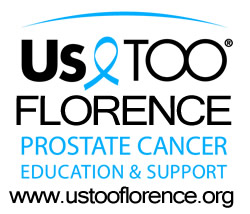|
||||||||
| Home | News You Can Use |
About Us TOO Florence |
Personal Journeys | Slideshows | Contact Us | |||
| Each man's Journey is listed under his BASIC treatment. When you click on one of the names to read a particular Journey, you may see one or more different treatments in bold lettering immediately above the Journey text. You will see (Recurrence) if they are due to a recurrence. Otherwise, they will be treatments used in conjunction with the basic treatment, i.e. Lupron with External Beam Radiation or External Beam Radiation with HDRT/Brachytherapy, etc. | |
Active Surveillance Alternative (Natural) Therapy Cryoablation - Freezing Hormone Therapy Radiation - Brachytherapy Radiation - External Beam Radiation - HDRT Surgery - Open Surgery - Robotic |
The phone rang one day in 2006 and my long time friend and urologist Robert Litin told me that a biopsy taken a few days earlier showed evidence of prostate cancer. That wasn't good news, but it was not entirely unexpected. From an initial PSA level of 3.1 in 1997 there had been a gradual increase to 6.8 in December of 2005 with some ups and downs in between. The decision to do a biopsy was simply out of an abundance of caution after a long history of rising PSA levels. The Gleason score, which gauges the severity of the cancer, was 6, which meant that the cancer was not very aggressive. Dr. Litin recommended "watchful waiting" but by August of 2007 the PSA level was 8.1 and another biopsy was ordered. This time there was no evidence of cancer. A prostate biopsy consists of shooting a tiny hollow needle into the prostate 10-12 times to obtain tissue samples. Since I had an enlarged prostate and evidently a fairly small amount of cancer, it wasn't a total surprise that a follow-up biopsy would miss the cancer. Watchful waiting continued. Late in 2008 Dr. Litin handed my care to Dr. Bryan Mehlhaff, who comes to Florence regularly. When the PSA level reached 11.6 in January of 2009, Dr. Mehlhaff ordered a third biopsy, and the news this time was disturbing. The Gleason score was 7 indicating the presence of a more aggressive cancer. I did not want to wait until the cancer grew beyond the prostate and Dr. Mehlhaff went over possible treatment options with me and my wife Peg. We concluded that surgical removal of the prostate was the best alternative, but Dr. Mehlhaff thought that at age 78 I should consider radiation rather than surgery. We consulted with the Medical Director of the Willamette Valley Cancer Institute, Dr. David Fryefield, and he also spent a considerable amount of time with us discussing alternative treatment, including High-Dose Rate (HDR) Brachytherapy, a method of temporarily implanting seeds twice through which the prostate would be subject to a very precise radiation exposure. Dr. Fryefield favored this form of radiation treatment and we were inclined to agree, but he warned that the prostate must be reduced in size to allow precise measurement of the gland before treatment could begin. I took Avodart for a few months, but there was not enough reduction in the size of the prostate. Dr. Fryefield told us that Brachytherapy would not be available, though he thought that we should consider Image Guided Radiation Treatment, which would involve traveling from Florence to Eugene for 45 treatments. Our conversation with friends who have experienced external radiation treatment for prostate cancer raised concerns about significant side effects long after the conclusion of treatment, however, and we were not enthusiastic about that alternative. At our next consultation with Dr. Mehlhaff we argued that few of his 78-year-old patients were participating in Cycle Oregon, a 450-mile bike trip, as I was preparing to do for the 18th time, and we returned to discussion of surgical removal of the prostate. He agreed to do a robotic-assisted radical prostatectomy which was then scheduled for October 1, 2009, at McKenzie Willamette Hospital, the only hospital in the Eugene-Springfield area with the equipment to do robotic surgery at that time. The night before the surgery we went on line and located a video of a robotic prostate surgery in Missouri, which, in hindsight, was not the wisest move. We learned that the procedure is very long and very demanding on the surgeon, with the patient in a head down position for the entire experience. Still, when it was over, and I returned to a hospital room from intensive care, I was astounded to discover that I was experiencing almost no pain. It is my belief that by avoiding the incision required for "open surgery" the period of recovery was relatively mild. The best part was confirmation that the cancer was gone when my first post op PSA came back at .008, the lowest reading possible, confirmed by another .008 earlier this month. We knew there would be side effects, and there were. It took several months to gain enough urinary control to stop using pads but now continence is not a problem. I am too modest to write much about the other near universal side-effect, erectile dysfunction, but clearly the post surgical experience can be a challenge to the male ego. Dr. Mehlhaff has been helpful in offering insight into this area, and an understanding wife has helped to make this aspect of recovery a good experience for both of us. I am grateful for the superb level of medical care available for those of us in this area with prostate problems, and, in retrospect, I feel confident that the path we took was the best available. During the months prior to surgery, and in the post-surgery period it has been especially helpful to have the Man to Man Prostate Cancer Support Group as a very special kind of resource. |
| www.ustooflorence.org Copyright © 2010 - 2025 | |

